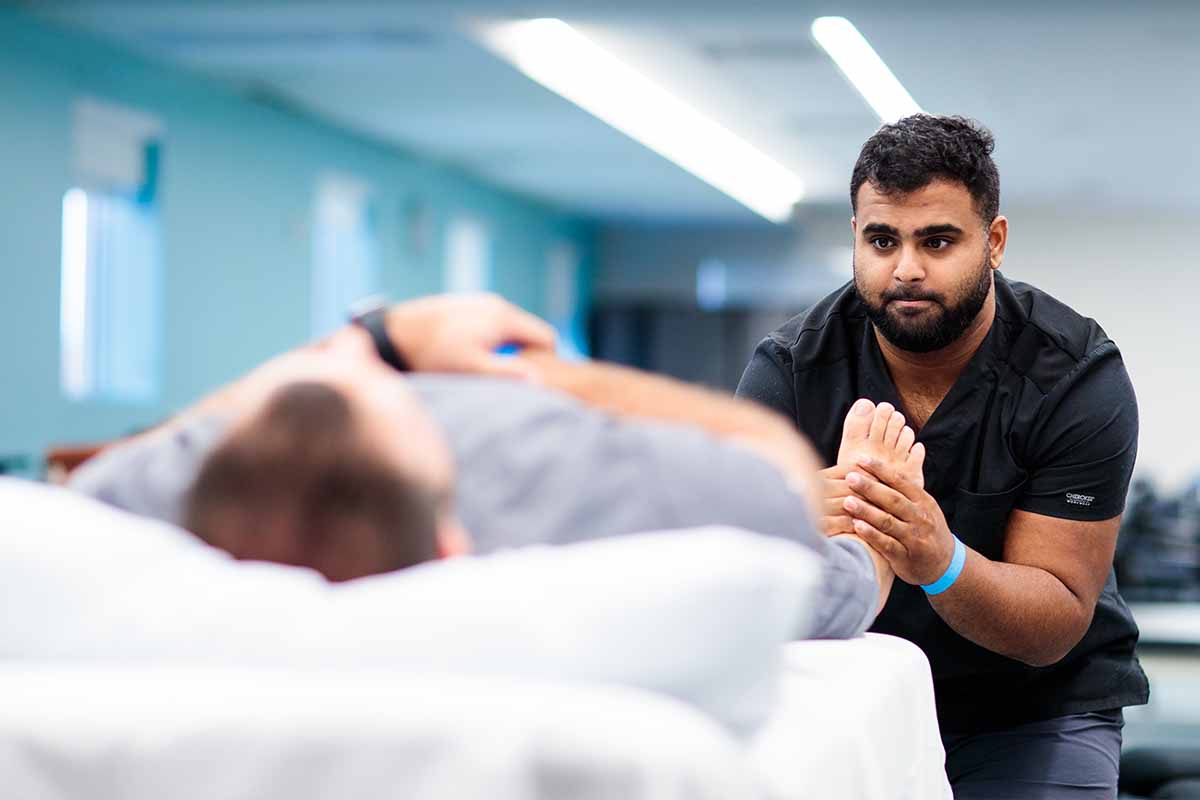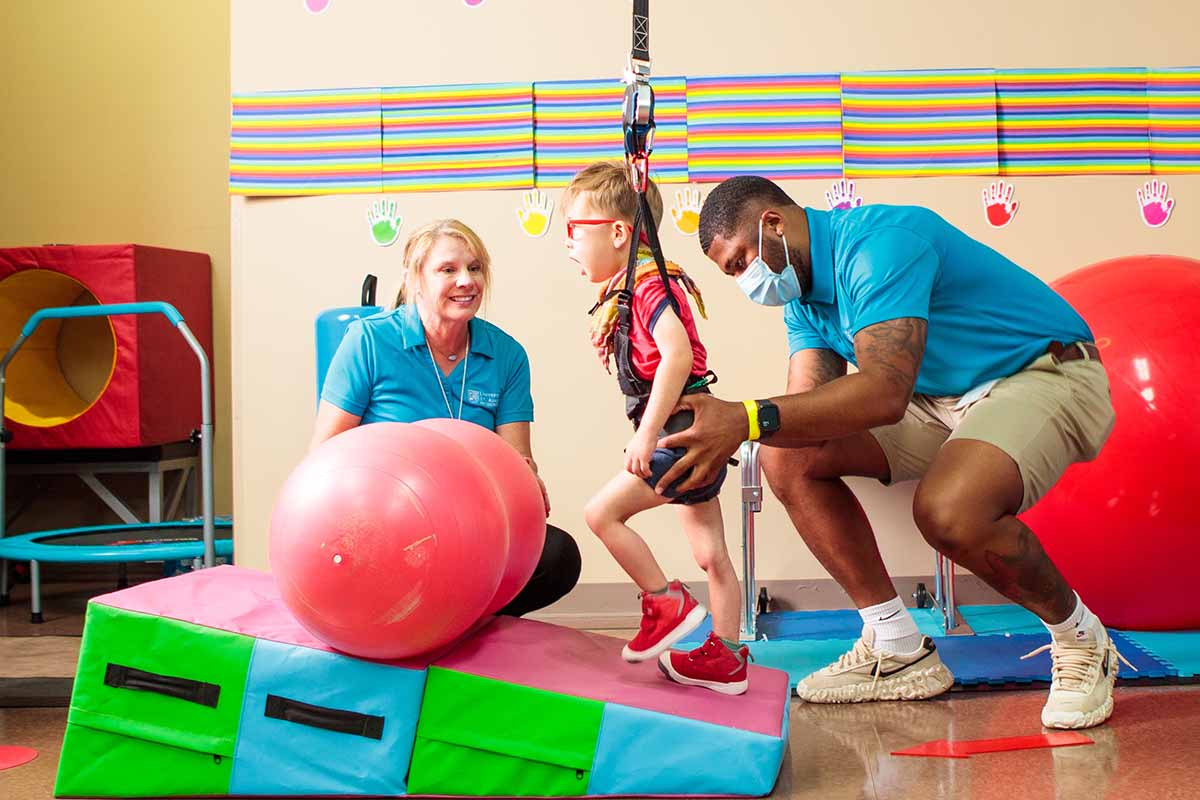
According to a survey conducted by Doximity, more than 83% of surveyed physicians expressed that telemedicine had proven valuable in improving the ongoing care for patients with complex or chronic conditions, while 65% noted it enhanced communication with their patients.1
Virtual healthcare is on the rise and provides promising solutions to challenges facing healthcare providers and consumers today. At the University of St. Augustine for Health Sciences, we prepare students to treat patients virtually by ensuring they have opportunities to practice delivering virtual care.
Learn more about virtual healthcare and how different areas of healthcare have adopted telehealth technology to provide services and care to patients.
What Is Virtual Care?


Virtual healthcare is an overarching term encompassing remote services across the healthcare industry. Telemedicine, which falls under virtual healthcare, includes delivering clinical services between the patient and the healthcare provider remotely. Alternatively, telehealth describes other related remote services, such as administration, ongoing medical education and training for healthcare providers.2
Virtual Care Communication Tools
Virtual care can improve patient engagement and help patients take control of their care. Virtual care communication tools include3:
- Videoconferencing software
- Interconnected personal health records with linked patient portals
- Remote health monitoring
- Wearable devices for gathering patient data and providing patient instruction
These communication tools may increase two-way interaction between patients and their healthcare providers in real-time and at their convenience.
What Does Virtual Healthcare Look Like?
Virtual healthcare and telehealth have expanded since the onset of the pandemic.2 Different areas of rehabilitative and health sciences have also evolved. Learn how telehealth continues to shape various healthcare occupations and what you can expect in the profession.
Occupational Therapy
Virtual occupational therapy tasks involve everything an in-person occupational therapist (OT) does, including:
- Patient evaluation
- Creation of a customized treatment plan
- Coaching the patient through different therapies to maximize function in the affected area
However, virtual OTs can complete these activities using videoconferencing tools and meeting with the patient virtually. Virtual OTs typically need to complete other tasks that in-person OTs don’t need to do, including:
- Testing technology equipment before each appointment
- Creating a plan to deliver resources to the patients before therapy sessions
At USAHS, we prepare our occupational therapy program students for telehealth roles, including opportunities to practice telehealth with pediatric and adult patients.
Speech-Language Therapy
Speech-language pathologists (SLPs) or speech therapists work with individuals with a wide array of physical and cognitive communication disorders.
SLPs can work with patients using telecommunication to provide the same services they would provide in person, including4:
- Addressing speech and language disorders
- Helping with swallowing and eating difficulties
- Assisting with social communication
- Retraining the voice
With online speech therapy, patients can connect with SLPs who can provide the specialized services they need.
Physical Therapy
A vvirtual physical therapist’s job is similar to an in-person physical therapist (PT)—they help patients regain their range of motion, manage pain and improve their quality of life.
For virtual PTs, this can look like:
- Verbally guiding the patient through exercises
- Performing the exercises with the patient
- Monitoring the patient’s movements
- Engaging in discussion
Virtual physical therapy provides services to patients living in rural areas or those who lack transportation and don’t have nearby PT clinics.
Telehealth Nurse
Telehealth nurses are registered nurses (RNs) who use virtual care communication tools, such as online portals and videoconferencing, to deliver patient care.5
Telehealth nursing job duties include 5,6:
- Monitoring vitals and medical data
- Communicating with patients through virtual care tools
- Identifying when a patient should seek medical attention
- Overseeing chronic illnesses
- Recommending treatment plans and educating patients
Becoming a telehealth nurse has many benefits, such as serving patients who may lack access to clinical services and minimizing the risk of contracting a disease.6
What Are the Benefits of Virtual Healthcare?
Virtual healthcare and telehealth can benefit the healthcare provider and the patient. Below are several advantages of expanding virtual healthcare.


1. Increases Patient Accessibility and Engagement
Allowing both patients and providers the opportunity to communicate asynchronously and share important health information through patient portals and teleconferencing can result in higher patient engagement.3
Patients and providers who are open to telehealth and comfortable using communication and information technology for clinical services are more likely to find satisfaction in their healthcare.3
88% of surveyed doctors share the opinion that telemedicine has expanded patients’ ability to receive healthcare, and a significant number of them have observed shorter wait times, better compliance with treatment plans and a reduction in missed appointments.1
As telemedicine becomes more available to more populations, it can potentially increase overall patient access to healthcare services.
2. Decreases Costs and Travel Expenses
The COVID-19 pandemic greatly impacted populations that needed regular visits with their provider. A JAMA Network study found telehealth appointments resulted in an average time savings of 2.9 hours in travel (round trip) and 1.2 hours spent at the clinic per visit for patients.7
3. Facilitates Patient Convenience
Virtual care is beneficial for those who are sick and want to avoid having to drive to their doctor’s office for an appointment and for those who need more flexibility with scheduling.8
Providers can also enjoy increased flexibility. A recent study found that telehealth can provide more job flexibility, such as working from home, and can improve provider quality of life.9
4. Decreases Spread of Infectious Diseases
Telehealth has shown evidence of significantly reducing the spread of COVID-19 and has a direct impact on decreasing the infection rate, including monitoring symptoms and promoting physical distance.10
Studies have also found that telehealth can potentially reduce the spread of infectious diseases with fewer in-person referrals while minimizing viral exposure and reducing labor for medical providers.11
What Does the Future of Virtual Healthcare Look Like?
We can expect to see the virtual healthcare and telehealth market grow as more areas of healthcare, like mental health, continue to adopt virtual care tools.12
While we can’t predict the future, there’s evidence that virtual healthcare will continue to expand. Take a look at the statistics below:
- If the adoption of virtual or telemedicine encounters were distributed uniformly across patient groups, more than 50 million in-person visits annually could convert to virtual interactions.13
- In a Doximity report, 70% of patients said they would be more likely to consult with a doctor if they could do so remotely, with the benefits of convenience and efficiency.1
- 83% of patients who had a telemedicine visit in the previous year said they want to continue or increase their use of telemedicine in the future.1
- Individuals covered by Medicaid (28.3%) and Medicare (26.8%), those who are Black (26.1%) and those earning less than $25,000 (26.4%) have the highest rates of telehealth visits.14
Launch Your Path in Virtual Healthcare With USAHS
Are you interested in a career involving telehealth and virtual care? USAHS allows students to practice virtual care in the classroom, with virtual clinical experiences in the MS-SLP program. Learn more about USAHS’ virtual clinical practice by contacting an enrollment advisor or requesting information.
The entry-level occupational therapy master’s degree program at the Dallas, Texas, campus has applied for accreditation and has been granted Candidacy Status by the Accreditation Council for Occupational Therapy Education (ACOTE) of the American Occupational Therapy Association (AOTA), located at 6116 Executive Boulevard, Suite 200, North Bethesda, MD 20852-4929. ACOTE’s telephone number c/o AOTA is (301) 652-AOTA and its web address is www.acoteonline.org. The program must have a preaccreditation review, complete an on-site evaluation and be granted Accreditation Status before its graduates will be eligible to sit for the national certification examination for the occupational therapist administered by the National Board for Certification in Occupational Therapy (NBCOT). After successful completion of this exam, the individual will be an Occupational Therapist, Registered (OTR). In addition, all states require licensure in order to practice; however, state licenses are usually based on the results of the NBCOT Certification Examination. Note that a felony conviction may affect a graduate’s ability to sit for the NBCOT certification examination or attain state licensure.
Students must complete 24 weeks of Level II fieldwork within 24 months following completion of the didactic portion of the program.
Sources:
- Doximity, “2023 State of Telemedicine,” Doximity, last modified 2023, https://press.doximity.com/reports/state-of-telemedicine-report-2023.pdf
- J Shaver, “The State of Telehealth Before and After the COVID-19 Pandemic,” National Library of Medicine, last modified April 2022, https://www.ncbi.nlm.nih.gov/pmc/articles/PMC9035352/
- L Burton, et al., “Empowering Patients Through Virtual Care Delivery: Qualitative Study With Micropractice Clinic Patients and Health Care Providers,” National Library of Medicine, last modified April 2022, https://www.ncbi.nlm.nih.gov/pmc/articles/PMC9049644/
- R Goldman, “Your Guide To The Best Online Speech Therapy,” Forbes, last modified June 2023, https://www.forbes.com/health/mind/best-online-speech-therapy/
- Coursera, “Telehealth Nursing: What It Is, Pay, and How to Get Started,” Coursera, last modified June 2023, https://www.coursera.org/articles/telehealth-nursing
- NurseJournal Staff, “Telehealth Nurse Career Overview,” NurseJournal, last modified October 2023, https://nursejournal.org/careers/telehealth-nurse/
- K Patel, et al., “Estimated Indirect Cost Savings of Using Telehealth Among Nonelderly Patients With Cancer,” JAMA Network, last modified January 2023, https://jamanetwork.com/journals/jamanetworkopen/fullarticle/2800164
- B Hasselfeld, “Benefits of Telemedicine,” John Hopkins Medicine, last modified June 2023, https://www.hopkinsmedicine.org/health/treatment-tests-and-therapies/benefits-of-telemedicine
- S Cannedy, et al., “Primary Care Team Perspectives on the Suitability of Telehealth Modality (Phone vs Video) at the Veterans Health Administration,” National Library of Medicine, last modified May 2023, https://www.ncbi.nlm.nih.gov/pmc/articles/PMC10184255/
- K Bouabida, et al., “Telehealth and COVID-19 Pandemic: An Overview of the Telehealth Use, Advantages, Challenges, and Opportunities during COVID-19 Pandemic,” National Library of Medicine, last modified November 2022, https://www.ncbi.nlm.nih.gov/pmc/articles/PMC9690761/
- F Shokri, The potential role of telemedicine in the infectious disease pandemic with an emphasis on COVID‐19: A narrative review,” National Library of Medicine, last modified January 2023, https://www.ncbi.nlm.nih.gov/pmc/articles/PMC9811063/#hsr21024-bib-0019
- GlobalData, “Telehealth to see robust growth in the near future, after recent post-pandemic slump,” Medical Device Network, last modified August 2023, https://www.medicaldevice-network.com/newsletters/telehealth-predicted-cagr-increase/
- J Eastburn, et al., “Is virtual care delivering on its promise of improving access?” Mckinsey & Company, last modified January 2023, https://www.mckinsey.com/industries/healthcare/our-insights/is-virtual-care-delivering-on-its-promise-of-improving-access
- E Lee, “Updated National Survey Trends in Telehealth Utilization and Modality (2021-2022),” ASPE Office of Health Policy, last modified April 2023, https://aspe.hhs.gov/sites/default/files/documents/7d6b4989431f4c70144f209622975116/household-pulse-survey-telehealth-covid-ib.pdf










